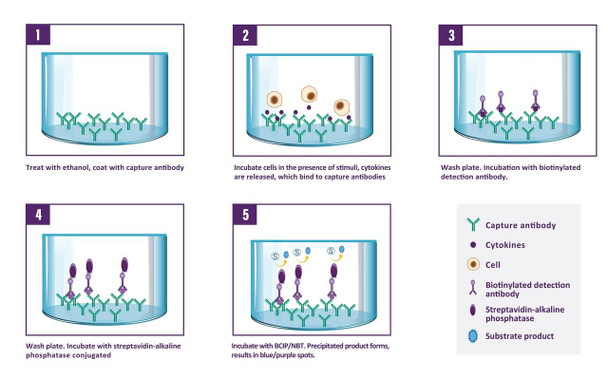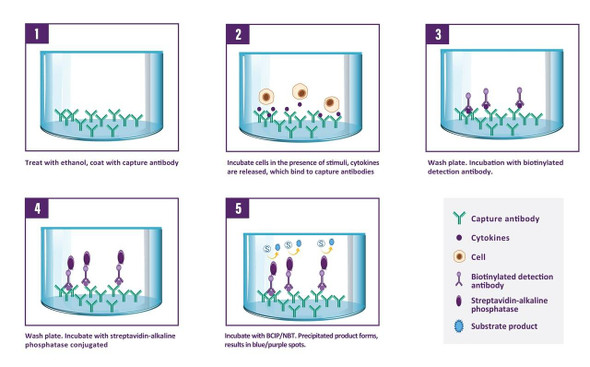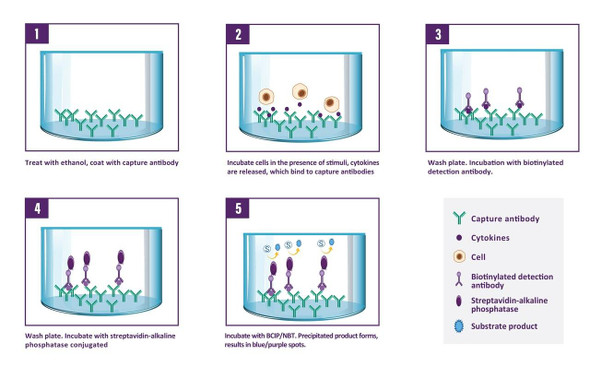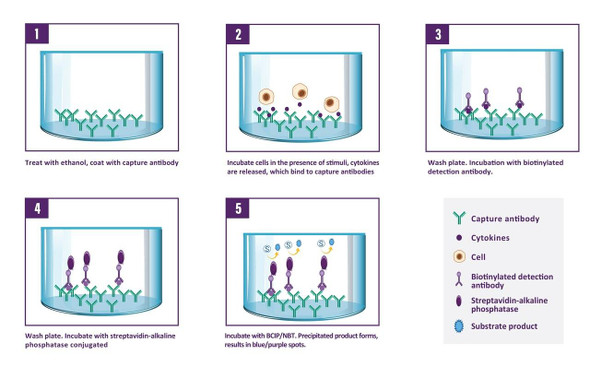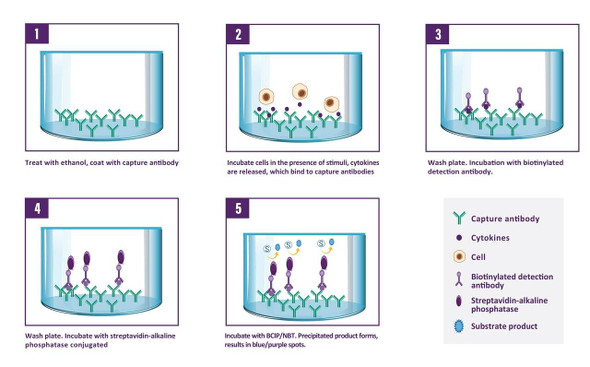Description
Human IL-17A/F ELISpot Pair
Assay Genie ELISpot is a highly specific immunoassay for the analysis of IL-17A/F production and secretion from T-cells at a single cell level in conditions closely comparable to the in-vivo environment with minimal cell manipulation. This technique is designed to determine the frequency of IL-17A/F producing cells under a given stimulation and the comparison of such frequency against a specific treatment or pathological state. Utilising sandwich immuno-enzyme technology, Assay Genie ELISpot assays can detect both secreted IL-17A/F (qualitative analysis) and single cells that produce IL-17A/F (quantitative analysis). Cell secreted IL-17A/F is captured by coated antibodies avoiding diffusion in supernatant, protease degradation or binding on soluble membrane receptors. After cell removal, the captured IL-17A/F is revealed by tracer antibodies and appropriate conjugates.
| Product type: | ELISpot Pairs |
| Size: | 10 x 96 Assays |
| Target species: | Human |
| Specificity: | Recognizes natural human IL-17A/F |
| Incubation: | |
| Kit content: | Assay Genie ELISpot matched antibody pairs are extensively validated and include pre-titrated capture antibody and biotinylated detection antibody. Antibodies are supplied in quantities sufficient for 10 x 96 samples. |
| Synonyms: | N/A |
| Uniprot: | Q16552 |
A capture antibody highly specific for IL-17A/F is coated to the wells of a PVDF bottomed 96 well microtitre plate either during kit manufacture or in the laboratory. The plate is then blocked to minimise any non-antibody dependent unspecific binding and washed. Cell suspension and stimulant are added and the plate incubated allowing the specific antibodies to bind any IL-17A/F produced. Cells are then removed by washing prior to the addition of Biotinylated detection antibodies which bind to the previously captured IL-17A/F. Enzyme conjugated streptavidin is then added binding to the detection antibodies. Following incubation and washing, substrate is then applied to the wells resulting in coloured spots which can be quantified using appropriate analysis software or manually using a microscope.
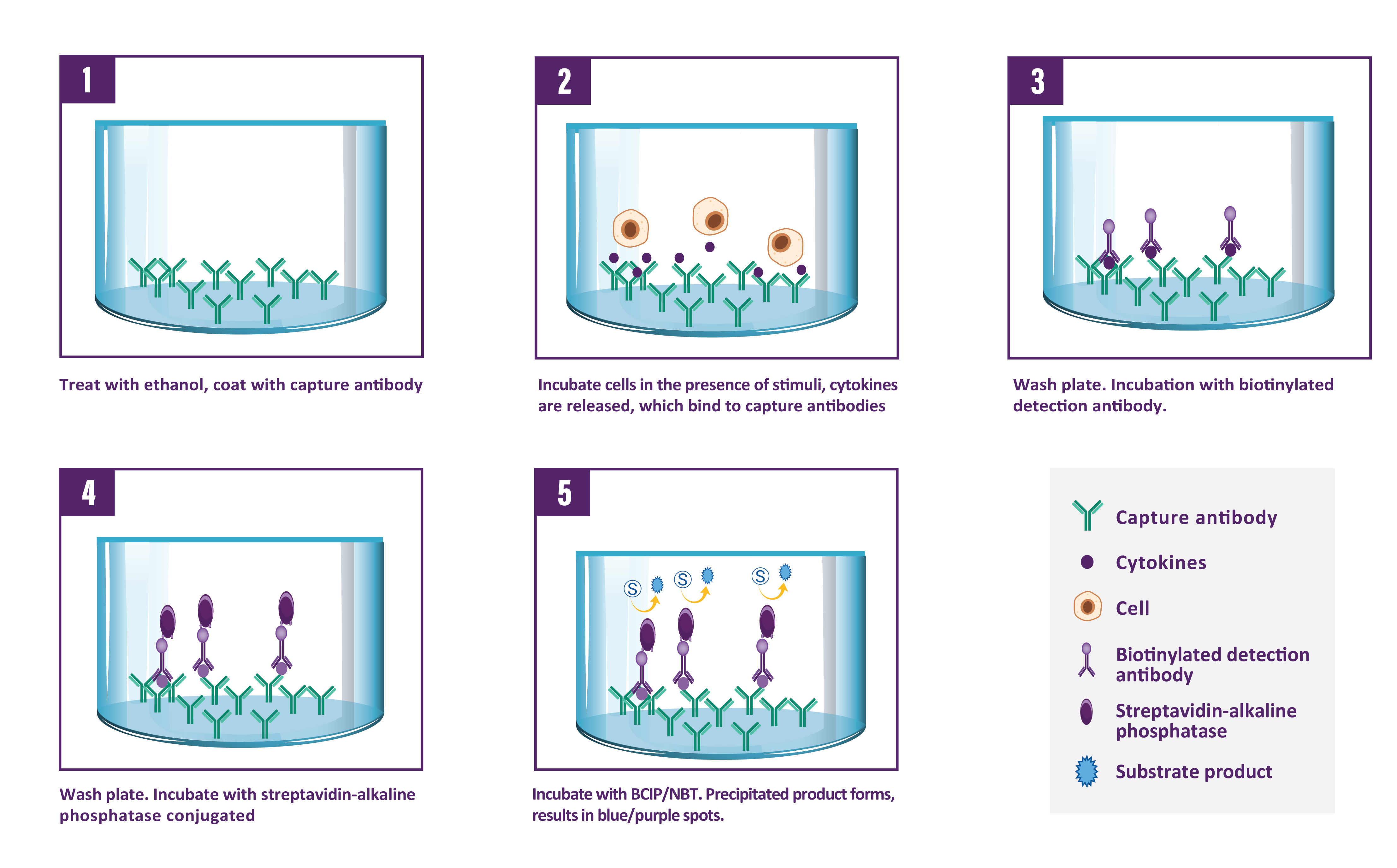
| Step | Procedure |
| 1. | Add 100 µl of PBS 1X to every well. |
| 2. | Incubate plate at room temperature (RT) for 10 min. |
| 2. | Incubate plate at room temperature (RT) for 10 min. |
| 3. | Empty the wells by flicking the plate over a sink & gently tapping on absorbent paper. |
| 3. | Empty the wells by flicking the plate over a sink & gently tapping on absorbent paper. |
| 4. | Add 100 µl of sample, positive and negative controls cell suspension to appropriate wells providing the required concentration of cells and stimulant. |
| 5. | Cover the plate and incubate at 37°C in a CO2 incubator for an appropriate length of time (15-20 hours). Note: do not agitate or move the plate during this incubation. |
| 6. | Empty the wells and remove excess solution then add 100 µl of Wash Buffer to every well. |
| 7. | Incubate the plate at 4°C for 10 min. |
| 8. | Empty the wells as previous and wash the plate 3x with 100 µl of Wash Buffer. |
| 9. | Add 100 µl of diluted detection antibody to every well. |
| 10. | Cover the plate and incubate at RT for 1 hour 30 min. |
| 11. | Empty the wells as previous and wash the plate 3x with 100 µl of Wash Buffer. |
| 12. | Add 100 µl of diluted Streptavidin-AP conjugate to every well. |
| 13. | Cover the plate and incubate at RT for 1 hour. |
| 14. | Empty the wells and wash the plate 3x with 100 µl of Wash Buffer. |
| 15. | Peel of the plate bottom and wash both sides of the membrane 3x under running distilled water, once washing is complete remove any excess solution by repeated tapping on absorbent paper. |
| 16. | Add 100 µl of ready-to-use BCIP/NBT buffer to every well. |
| 17. | Incubate the plate for 5-15 min monitoring spot formation visually throughout the incubation period to assess sufficient colour development. |
| 18. | Empty the wells and rinse both sides of the membrane 3x under running distilled water. Completely remove any excess solution by gentle repeated tapping on absorbent paper. |
| 19. | Read Spots: allow the wells to dry and then read results. The frequency of the resulting coloured spots corresponding to the cytokine producing cells can be determined using an appropriate ELISpot reader and analysis software or manually using a microscope. Note: spots may become sharper after overnight incubation at 4°C in the dark. |
| UniProt Protein Function: | IL17A: Induces stromal cells to produce proinflammatory and hematopoietic cytokines. Enhances the surface expression of ICAM1/intracellular adhesion molecule 1 in fibroblasts. Belongs to the IL-17 family. |
| UniProt Protein Details: | Protein type:Secreted; Secreted, signal peptide Chromosomal Location of Human Ortholog: 6p12 Cellular Component: extracellular space; external side of plasma membrane Molecular Function:cytokine activity Biological Process: cell death; cell-cell signaling; apoptosis; positive regulation of interleukin-23 production; positive regulation of osteoclast differentiation; protein amino acid glycosylation; positive regulation of transcription from RNA polymerase II promoter; immune response; inflammatory response |
| NCBI Summary: | The protein encoded by this gene is a proinflammatory cytokine produced by activated T cells. This cytokine regulates the activities of NF-kappaB and mitogen-activated protein kinases. This cytokine can stimulate the expression of IL6 and cyclooxygenase-2 (PTGS2/COX-2), as well as enhance the production of nitric oxide (NO). High levels of this cytokine are associated with several chronic inflammatory diseases including rheumatoid arthritis, psoriasis and multiple sclerosis. [provided by RefSeq, Jul 2008] |
| UniProt Code: | Q16552 |
| NCBI GenInfo Identifier: | 2498481 |
| NCBI Gene ID: | 3605 |
| NCBI Accession: | Q16552.1 |
| UniProt Secondary Accession: | Q16552,Q5T2P0, |
| UniProt Related Accession: | Q16552 |
| Molecular Weight: | 17,504 Da |
| NCBI Full Name: | Interleukin-17A |
| NCBI Synonym Full Names: | interleukin 17A |
| NCBI Official Symbol: | IL17A‚ ‚ |
| NCBI Official Synonym Symbols: | IL17; CTLA8; IL-17; IL-17A‚ ‚ |
| NCBI Protein Information: | interleukin-17A; CTLA-8; cytotoxic T-lymphocyte-associated antigen 8; cytotoxic T-lymphocyte-associated protein 8; interleukin 17 (cytotoxic T-lymphocyte-associated serine esterase 8) |
| UniProt Protein Name: | Interleukin-17A |
| UniProt Synonym Protein Names: | Cytotoxic T-lymphocyte-associated antigen 8; CTLA-8 |
| Protein Family: | Interleukin |
| UniProt Gene Name: | IL17A‚ ‚ |
| UniProt Entry Name: | IL17_HUMAN |
| UniProt Protein Function: | Ligand for IL17RA and IL17RC (PubMed:17911633). The heterodimer formed by IL17A and IL17F is a ligand for the heterodimeric complex formed by IL17RA and IL17RC (PubMed:18684971). Involved in stimulating the production of other cytokines such as IL6, IL8 and CSF2, and in regulation of cartilage matrix turnover (PubMed:11591732, PubMed:11591768, PubMed:11574464). Also involved in stimulating the proliferation of peripheral blood mononuclear cells and T-cells and in inhibition of angiogenesis (PubMed:11591732). Plays a role in the induction of neutrophilia in the lungs and in the exacerbation of antigen-induced pulmonary allergic inflammation. |
| NCBI Summary: | The protein encoded by this gene is a cytokine that shares sequence similarity with IL17. This cytokine is expressed by activated T cells, and has been shown to stimulate the production of several other cytokines, including IL6, IL8, and CSF2/GM_CSF. This cytokine is also found to inhibit the angiogenesis of endothelial cells and induce endothelial cells to produce IL2, TGFB1/TGFB, and monocyte chemoattractant protein-1. [provided by RefSeq, Jul 2008] |
| UniProt Code: | Q96PD4 |
| NCBI GenInfo Identifier: | 239938888 |
| NCBI Gene ID: | 112744 |
| NCBI Accession: | Q96PD4.3 |
| UniProt Secondary Accession: | Q96PD4,Q6NSI0, Q7Z6P4, Q96PI8, Q9NUE6, |
| UniProt Related Accession: | Q96PD4 |
| Molecular Weight: | 18,045 Da |
| NCBI Full Name: | Interleukin-17F |
| NCBI Synonym Full Names: | interleukin 17F |
| NCBI Official Symbol: | IL17F‚ ‚ |
| NCBI Official Synonym Symbols: | ML1; ML-1; CANDF6; IL-17F‚ ‚ |
| NCBI Protein Information: | interleukin-17F |
| UniProt Protein Name: | Interleukin-17F |
| UniProt Synonym Protein Names: | Cytokine ML-1 |
| Protein Family: | Interleukin |
| UniProt Gene Name: | IL17F‚ ‚ |

